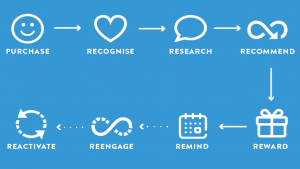13 Mar Why aren’t my customers coming back? Thinking beyond path to purchase

Surely every customer has the potential to become a customer for life? It depends on how you found them in the first place.
Many brands are grappling with the evolution of customer behaviour and rising expectations, losing margin by being trapped in a price war or wasting their marketing budget acquiring customers who probably won’t come back.
What is important is how you find and engage those customers who do have a high potential of returning – why is customer relevancy so important and what does their path to re-purchase look like?
The price war – win on price, you lose on price
Let’s think back to how you first attracted the customer to your business. Was it a ‘sale’ campaign that captured their attention? If the answer is yes, there will be trouble ahead – we guarantee it.
You cannot buy loyalty, it must be earned. If a customer was so easily swayed to you because you offered a better price than a competitor, they will be just as easily swayed away – it doesn’t matter how exceptional the service or experience was. Bargain hunters are only loyal to the price – not the brand.
By attracting new customers through price, you also run the risk of setting a perceived expectation to the customer – they will come to expect a discount or offer every time they shop with you and when they don’t receive it, they become disgruntled and shop elsewhere.
Finally, consider what they just purchased before sending the next promo do not contact them post-purchase with a sale, promoting the item they purchased yesterday as 50% off today. You’ve probably been there yourself, there’s nothing worse than when this happens. They will immediately lose respect for your brand.
Gaining a competitive advantage
What other tactics can you use to retain the customer? Have you undergone a value analysis to learn what sets you apart from your competitors? It’s all about how you can add additional value to the customer. Apple is a great example here, when you purchase a new product from them, you receive a complimentary 30 minute session with an Apple expert to show you how to make the most of the product. Not only are they selling you a product, but they are providing additional value in showing you how to effectively use it.
If you’re keen to understand or re-evaluate how your brand can add value to your customers, we recommend Bain and Co’s 30 elements of value model.
Why customer relevancy matters
Don’t waste your efforts (or money) trying to continue the wrong conversation at the wrong time with the wrong customers. Think of the impact on company profits by reducing the marketing cost per sale (ROAS).
Target the customers you can continue to deliver value to. Think of the reason why they would shop with you vs others, why wouldn’t they shop with you. Assess the likelihood that the customer will be back.
Last year, I made a one-off business trip to Adelaide, and visited a local juice bar. I was offered the opportunity to sign up for their loyalty card (buy 4, get the 5th free). I explained several times that I likely won’t be back – however, the cashier wouldn’t take no for an answer – most likely they had a target number to sign up that day. So, I felt pressured into signing up, yet have never been back. This is a solid example of wasting your efforts on the wrong type of customer (yes, they do exist).
Customer segmentation is so important to help you determine which of your customers you should be focusing your efforts on. Customology helps businesses learn exactly who these customers are by conducting a waterfall analysis – this approach identifies how revenue went from A to B over a period of time through the lens of different customer groups. We will be sharing more on this in the coming weeks.
The customer journey – beyond path to purchase
Too many organisations are spending their efforts focusing on the path to purchase journey – most often using discounts and offers to attract new customers. As we’ve already discussed, this isn’t the most effective customer attraction strategy.
80% of your future profits will come from just 20% of your existing customers¹. Existing being the key word here! How much time does your business spend on the path to re-purchase?
Our recent article revealed how critical the moneymoon period is once you have acquired a new customer. To enable the path to re-purchase you need to continue a relevant and meaningful conversation with the customer. The above graphic represents our view of the path to re-purchase. There are 4 R’s which are particularly important:
Recognise your customer – thank them for shopping with you, for choosing you above others
Research – ask the customer what they are interested in, curate the messaging for them
Reward – reward the behaviour you want to influence
Remind – remind your customers of the benefits of your value proposition
Summary
So, we’ve established the importance of attracting customers that can add future value to your business. Good price and good service are a given – customers already expect this as a minimum. You can’t buy loyalty – but you can influence it.
Undertake an effective customer segmentation analysis to identify the sales growth opportunities for your business.
Continue the conversation with the customer, treat them as an individual. Focus beyond the path to purchase, but rather on the path to re-purchase to drive engagement and customer loyalty.
Customology are specialists in customer lifecycle management. Contact a Customologist today on 07 3902 7700 or hi@customology.com.au for more information on how your business can identify the customer groups who can add real value to your business, and drive customer loyalty.

